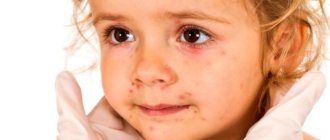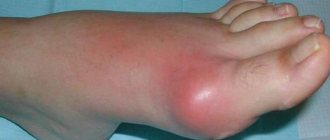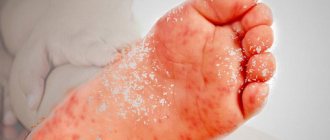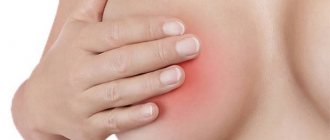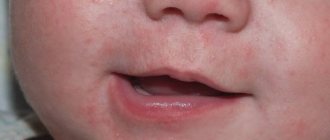Armpit rashes can occur for a variety of reasons, but are usually caused by sensitive skin, sweat, chafing, irritation from shaving, and lack of hygiene.
In most cases, the rash is a temporary symptom that can usually be treated with simple medications and home remedies.
However, some causes of armpit rash require medical attention and treatment.
Let's look at the different types of armpit rash and explain treatment options for each.
Causes and symptoms of armpit rash
There are many different causes of armpit rash. The most common ones are listed below.
Skin chafing
Armpit rashes in adults and children can occur due to rubbing of the skin, which causes irritation. Areas of the body where the skin flexes are especially susceptible to irritation.
In this case, the rash has the following symptoms:
- Red color;
- irritated and chafed skin;
- burning and itching;
- irritation often appears in stripes;
- swelling and cracked skin in severe cases.
Often such a rash under the arms occurs during physical training, uncomfortable clothing, or excessive sweating.
Many also experience this problem during the spring and summer months, with increased sweating and damp skin becoming irritated more quickly.
Heat rash under arms
Exposure of the skin to heat and sweat can cause irritation and rashes. In most cases, such a bittern under the arms causes a rash that has the following characteristic features:
- small size;
- Red color;
- slightly raised rash.
This rash often occurs during the hot season or in hot climates.
Irritation after waxing or shaving underarms
Often a rash under the arms occurs after depilation or shaving. In most cases, it is not dangerous and goes away over time.
Contact dermatitis
Contact dermatitis occurs when contact with an allergen or irritant triggers an immune response. This allergic reaction usually develops within a few hours of exposure to allergens.
Contact dermatitis causes the following symptoms:
- itching;
- redness;
- blisters;
- dryness.
There are many different causes of contact dermatitis. Some of the most common:
- chemicals in cleaning and personal care products;
- food or environmental allergens;
- medicines;
- insect bites.
Eczema
Eczema is a non-contagious, chronic condition characterized by inflammation of the skin. This occurs most often in areas of the body where there are skin folds.
Eczema is common in children.
Eczema causes the following symptoms:
- redness;
- itching;
- dryness;
- cracks;
- Clear liquid may be released when scratched.
Eczema rashes usually last for more than a week. A rash may appear on the armpit along with similar spots on other parts of the body such as the elbows, back of the knees and neck.
People with eczema may experience flare-ups at certain times of the year or when they are sick or stressed.
Seborrheic dermatitis
Seborrheic dermatitis is a type of eczema that develops around the oil glands. This causes symptoms that are different from those of eczema.
Seborrheic dermatitis contributes to the following symptoms:
- redness;
- oily skin;
- edema;
- itching and burning;
White or yellow flakes may also form on the skin.
Fungus
A type of fungus called Candida causes yeast infections. Candida usually causes a rash that causes:
- itching;
- edema;
- redness;
- peeling.
Ringworm
Ringworm is a common type of fungal infection that causes a red rash.
Ringworm can be caused by:
- swelling;
- edema;
- dryness;
- peeling;
- itching
Hidradenitis
A purulent-inflammatory process affecting the apocrine glands. The location of hidradenitis is the armpits, the area around the navel, and the nipples of the genitals. Small infiltrates form in the layers of the skin, which, as they increase in size, become fused with each other and with the surrounding tissues. As a result, a painful blue-purple infiltrate is formed. The disease is characterized by a chronic and recurrent course.
How to treat armpit rash at home
Most armpit rashes that result from allergic reactions or general skin irritation respond well to home treatment. You can try the following methods:
- keep your armpits cool and dry by wearing loose and protective clothing;
- spend less time in the sun and try not to sweat;
- if the rash is allergic, contact with the allergen must be avoided;
- when the rash itches, try to gently stroke it rather than scratch it;
- take a warm bath with oatmeal, vinegar, salt or baking soda;
- Apply glycerin-based moisturizers and medicated ointments and creams several times a day.
- Avoid long periods of time in water, including long showers or baths.
Some natural treatments may also help reduce most armpit rashes, but it's worth noting that there is little scientific evidence to support their use.
Alternative Home Remedies to Treat Armpit Rash:
- Coconut oil;
- topical vitamin B-12;
- sunflower oil;
- hypnosis;
- meditation;
- acupressure, which involves applying pressure to specific points on the body;
- massage.
Some of the causes that cause subcutaneous rashes require treatment using over-the-counter medications.
Over-the-counter treatments for allergic reactions and other skin irritations include:
- applying over-the-counter hydrocortisone creams (0.5-1.0%) several times a day for several days;
- antihistamines, some of which contain ingredients that cause drowsiness, which can make it easier to sleep and thus prevent scratching;
- use of lotions or creams;
- Applying over-the-counter antifungal creams, gels, or sprays daily for 2 weeks if Candida or ringworm is the cause of the rash.
Armpit rashes that occur as a result of chronic skin diseases often require treatment. However, in most cases, your doctor will recommend trying a mixture of over-the-counter medications and home remedies before prescription medications.
Prescription treatment options for people with eczema include:
- topical steroid creams;
- topical PDE4 inhibitors or calcineurin inhibitors;
- phototherapy, which uses ultraviolet light to increase vitamin D production;
- biological preparations that contain modified versions of human immune proteins.
Treatment options for seborrheic dermatitis include:
- the use of antifungal creams;
- washing the area with products containing zinc pyrithione;
- softening scaly patches every few days with exfoliating products using topical corticosteroids, prescription antifungal creams, or nonsteroidal creams during flare-ups, as directed.
What to do if a pimple in the armpit area hurts?
In addition to aesthetic discomfort, the rash may be accompanied by itching, burning, and pain. If a pimple in the armpit area hurts, you should consult a dermatologist to find out the cause of its occurrence. Sometimes acne can be combined with hidradenitis, and the doctor will prescribe complex treatment for different areas. To combat mild to moderate acne, your doctor may recommend azelaic acid, for example, Azelic®9 gel.
This is a drug that helps reduce the level of free fatty acids and normalize keratinization processes5. Azelik® gel exhibits antimicrobial activity against Propionibacterium acnes and Staphylococcus epidermidis5. The anti-inflammatory effect of the drug is based on the ability to reduce the metabolism of neutrophils and their production of free radical forms of oxygen5.
Prevention
Understanding what causes armpit rashes can help minimize their problems.
General recommendations for preventing underarm rashes include:
- identifying and avoiding allergens where possible;
- using natural, unscented skin care products;
- regularly bathing in warm water, but not for a long time;
- using powders to prevent chafing in warm weather or wearing clothes and underwear that fit properly;
- frequent washing of clothes, bedding and towels;
- washing hands or body after contact with soil, animals and plants;
- Avoid sharing towels, combs or clothes with other people;
- wearing loose clothing made from natural materials in hot weather;
- providing pets and farm animals with all recommended vaccinations.
Folk remedies
The reasons for the appearance of red spots can be different, each of them requires an individual approach when choosing a treatment method. With the appearance of such symptoms, folk remedies that use medicinal plants and products available in every home in their recipes are quite effectively dealt with.
A mixture of poplar and birch buds infused with alcohol is no less effective in reducing the activity of the fungus. The kidneys are crushed in equal quantities and infused in good vodka or alcohol. Before treating the skin, alcohol is diluted with water.
The fungus responds well to treatment with tar; for this purpose, pharmaceutical purified tar and tar soap are used.
Fungal diseases are treated with garlic or radish compresses, however, this remedy should be applied carefully to skin with weeping rashes. It helps well by relieving the symptoms of itching and eliminating inflammatory processes, decoctions of chamomile, lingonberry leaf, St. John's wort - they are brewed and drunk as tea.
Decoctions of chamomile, lingonberry leaf, and St. John's wort herb help well by relieving the symptoms of itching and eliminating inflammatory processes - they are brewed and drunk as tea.
If discomfort in the armpit area is associated with sweating, you can get rid of it with chamomile infusion. Pour 1 spoon of herb with a glass of boiling water. Let stand for 20 minutes, strain. Pour 2 tablespoons of apple cider vinegar into the product. Wash irritated areas 3-4 times a day.
In hot weather, a decoction of oak bark will be a means of controlling sweat. It has an astringent effect and normalizes the functioning of the sweat glands.
You can wash the axillary area with a solution of sea salt (2 tablespoons per 0.5 liters of water). Before use, strain through several layers of gauze.
Possible complications
With proper care, most armpit rashes do not cause any complications. However, without proper attention to the problem, scarring and infections can develop. Scars from such rashes usually occur after severe scratching or infection.
Chronic, severe rashes or those that do not go away with basic treatment tend to have a wider range of complications.
For example, there is a long list of allergic conditions that are associated with eczema, including asthma and allergic contact dermatitis. In addition, serious fungal and bacterial infections can lead to life-threatening complications, including sepsis and organ failure.
Fungus in the armpit
fungus under the armpits in the photo
In addition to the listed reasons for the appearance of allergies in the armpits, special attention in medicine is paid to such a phenomenon as infection with a fungus such as candida or lichen. Typically, people who suffer from vitamin deficiency, excessive sweating and general disorders of the immune system are susceptible to such an infection.
Also, the effect of urticaria can be observed when the integrity of the skin changes for various reasons.
Candidiasis that appears in the armpit area is distinguished by its special symptoms:
- the formation of zonal diaper rash, which is very itchy and causes pain when scratched;
- peeling in the folds, and it is often accompanied by a white coating, similar in consistency to flour, usually accompanied by a specific odor;
- pain can also be caused by cracks caused by a fungus that violates the integrity of the skin.
In addition, the risk of infection is much higher if there is regular contact of the skin of the body with synthetic fabrics, as well as with any damage to the epidermis. The fungus can easily spread to other areas of the body on the hands when scratched.
In addition to candida, itching in the area under the arms can be caused by such types of fungus as pityriasis versicolor, lichen zhibert and linear. Only a qualified dermatologist can diagnose this or that type of infection; he will also determine the cause of the problem and draw up an adequate plan for getting rid of it.
The duration of treatment for fungus in the armpits varies; the course of therapy can be at least five weeks. Sometimes it takes more than 10 weeks to completely get rid of the disease
It is important to review your diet, which will reduce excessive sweating, which has a detrimental effect on the entire therapy process. In addition, the doctor may prescribe the following medications:
- Mikonorm;
- Tibesil;
- Lamisil;
- Clotrimazole.
In addition to the local application of ointments, dermatologists practice additional therapy from the inside using the following tablets:
- Ketoconazole;
- Fluconazole;
- Itraconazole
It is important to strengthen the body’s immune system during the treatment of fungus in the armpit, since the infection can only be eliminated if one is in complete health
Rash in the groin in women
Rashes in the groin area in women may be evidence of a pathological abnormality in physiology, the presence of an infectious disease, or the development of a neoplasm of varying quality. In normal condition, the outer covering of the genital organs should be smooth, so the presence of a rash in any form is a reason to urgently consult a doctor.
At first glance, harmless changes in the structure and color of the epidermis can seriously threaten the health of the entire body, hiding dangerous pathological processes that gradually destroy the normal functioning of the reproductive system. As a rule, rashes appear suddenly and in large quantities.
There are the following types of groin rash in women:
- ordinary pimples, filled with liquid of various colors and appearing in the form of bubbles, blisters or bumps;
- purulent formations of various diameters and a liquid filling of a cloudy color, which is purulent exudate;
- condylomas are inflammatory branches of the papillary seals of the epidermis;
- erythema is characterized by bulges of pinkish or bright burgundy color;
- nodes are subcutaneous compactions in the form of neoplasms.
Any type of groin rash in women is a symptom of the development of another pathology directly related to the reproductive system. Also, a rash is a kind of signal about a violation of the rules for caring for the intimate area, an allergy to cosmetics or poor-quality depilation. Only a doctor can identify a more accurate cause of external manifestations based on the results of diagnostic measures.
Calling a dermatologist at home for a rash in the groin
Not everyone has the opportunity to personally visit a doctor in our clinic if they develop rashes in the groin area. In such situations, a dermatologist is called to your home.
You can use the service in any of the most convenient ways:
- Call one of the specified clinic phone numbers with a brief description of the symptoms of the disease that has arisen. The dermatologist will visit the patient on the same day of treatment, excluding holidays and weekends.
- Filling out an electronic application on the official website of our medical center. To do this, you need to provide all the necessary information in special fields in the online application form. The dispatcher will contact the patient as soon as possible using the phone number provided to confirm the most convenient time for the doctor’s visit.
- Registration entry. This calling method may be required by patients who have a follow-up appointment but no longer wish to attend the clinic due to lack of time or other personal reasons. By contacting the registrar, you will need to briefly describe the situation and agree on the date, address and time of the dermatologist’s visit.
When choosing any type of treatment, you should be prepared to provide certain personal information. All personal data of patients is kept in strict confidentiality.
Ointments used for groin rash
When forming a course of therapy, the dermatologist is guided by the cause that provoked the manifestation of the rash in the groin and the form of development of the pathology. When prescribing research activities, certain factors are taken into account, such as damage to certain areas of the skin, the type and nature of the rash.
Based on the test results, the following ointments may be prescribed:
- "Bepantol" promotes rapid restoration of damaged skin, drying wounds and abrasions;
- “Desitin” forms an enveloping protective film over the affected areas, which speeds up the process of restoration of structural tissues, and also protects against the effects of sweat and urine on the localization of the rash;
- "Lamisil" is used against infectious fungi;
- "Drapolene" is used as an antiseptic to soften and relieve skin irritation;
- "Pantestin" prevents infectious spread to neighboring areas.
Quite often, an ointment based on the zinc component is prescribed. Its use helps relieve itching and swelling, followed by drying of the skin in areas where the rash is localized.
Where to go with a groin rash
An experienced dermatologist from our clinic is ready to see a patient on the most convenient day for him, excluding holidays and weekends. At the first appointment, a history will be taken and an examination will be carried out, following which a referral will be issued for subsequent pathology diagnostics in order to identify the pathogen and make the most accurate diagnosis.
Based on all the research activities carried out, a conclusion is drawn and a therapeutic course is drawn up, taking into account the individual characteristics of the patient.
Symptoms that require immediate medical attention:
- pinkish rashes that are constantly increasing in size;
- simultaneous localization on the inguinal folds, perineal area and around the anus;
- the rashes flake, itch and cause severe discomfort when walking;
- acute itching of the affected areas of the skin;
- increased body temperature;
- the rash does not go away for a long time.
People facing problems caused by the formation of a groin rash are exposed to an additional stressful situation. Our clinic offers anonymous treatment, with complete confidentiality of all information provided by the patient.
| Appointment with a dermatologist at the clinic. Call a dermatologist at home. | Reception is strictly by appointment, make an appointment by phone: +7 | Prices for services | Reviews about the clinic |
Treatment of groin rash
The determination of the treatment method in the presence of pathological rashes in the intimate area is formed on the basis of an initial examination, medical history and the results of diagnostic measures. If an allergic reaction is detected, the diet is analyzed in order to adjust it and identify the product that contributes to the development of a rash in the groin.
It is also recommended not to use tight underwear and give preference to natural fabrics.
Certain methods of therapy are distinguished when identifying diseases not related to problems of personal hygiene and allergies:
- if a viral or bacteriological rash is detected, antifungal agents are used to treat the affected areas;
- special lotions based on a weak iodine solution are applied;
- certain ointments and gels are used to treat the groin area in places where rashes appear;
- Special vitamin complexes are prescribed to strengthen the immune system.
For patients suffering from excessive sweating, it is recommended to use baby powders and hygienic infusions of chamomile or oak bark. The use of any medications without a doctor's prescription may contribute to the development of additional complications.
Diagnostics
First of all, one of the most effective and popular methods is an external inspection of the damaged area. During the visual identification of certain above-mentioned signs, diagnosis practically comes down to one option.
Why can our articles be trusted?
We make health information clear, accessible and relevant.
- All articles are checked by practicing doctors.
- We take scientific literature and the latest research as a basis.
- We publish detailed articles that answer all questions.
Also of great importance is palpation of the pathological growth to determine the size, consistency and temperature of the lesion.
But examination and palpation are sometimes insufficient measures to establish an accurate diagnosis: at the moment, specialists conduct a general blood test. A biological fluid must be collected for bacteriological diagnosis of the causative agent of the disease.
Treatment of this type includes several interrelated elements. To cure the disease, it is necessary to use a combination of drug treatment and traditional medicine. The use of surgical intervention is used in exceptional situations.



